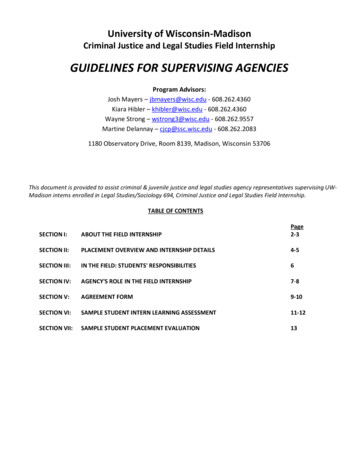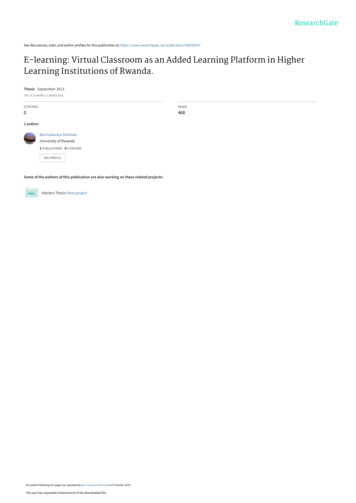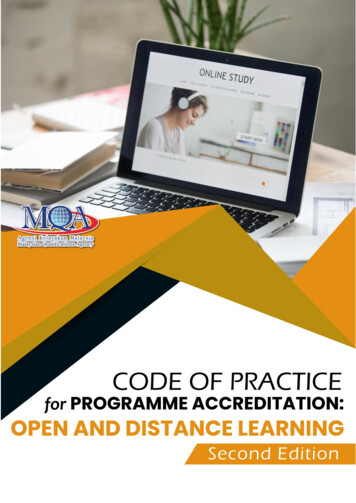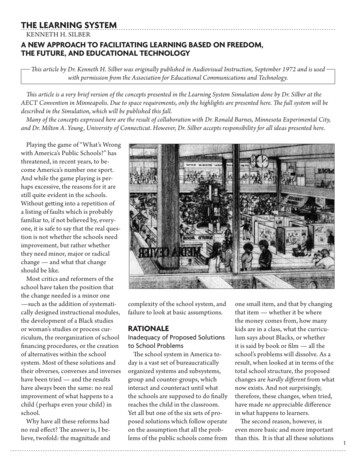
Transcription
LEARNING AND SUPERVISING .A Guide for Participants and Supervisors in theProfessional Development Process PilotHOSPITAL SKILLS PROGRAM 2012
NSW Health Education and Training Institute (HETI)Building 12Gladesville HospitalGLADESVILLE NSWTel. (02) 9844 6551Fax. (02) 9844 6544www.heti.nsw.gov.auinfo@heti.nsw.gov.auPost: Locked Bag 5022GLADESVILLE NSW 1675Hospital Skills Program, Professional Development Process Pilot. Sydney: HETI, 2012.The Hospital Skills Program acknowledges that for the purposes of the Professional DevelopmentProcess Pilot, this guide has been reproduced with permission using content sourced wholly fromthe following resources:The Superguide: a handbook for supervising doctors in training (November 2010 1st Edition) ISBN:(pbk.) 978-0-9806955-9-5The Superguide: a handbook for supervising allied health professionals (April 2012 2nd Edition) ISBN9780987193629 (pbk.)The Learning Guide: a handbook for allied health professionals facilitating learning in the workplace.This work is copyright. It may be reproduced in whole or in part for study or training purposes subject to theinclusion of an acknowledgement of the source. It may not be reproduced for commercial usage or sale.Reproduction for purposes other than those indicated requires written permission from HETI. HETI July 2012.
Table of ContentsAbout this handbook .3The supersummary .4Part one .6What is supervision? .6Introduction: the purpose of clinical supervision .6Facilitating clinical supervision .6Who provides clinical supervision? .7Methods of supervision.7Tips for rural and remote clinicians .8Confidentiality .8Documenting supervision sessions .9Clinical supervision activities . 10Group supervision . 11Part two. 13How to be an effective clinical supervisor . 13What makes an effective clinical supervisor? . 13Barriers to effective supervision. 14Knowing your supervisee’s competence level. 15Giving feedback . 16Supervisee engagement in supervision . 17What makes the non-specialist workforce feel valued?. 17Tips to foster engagement of the supervisee. 17Responsibilities of the supervisee. 18Part three . 19Clinical teaching and learning . 19The supervisor’s role in clinical teaching . 19Promoting a culture of life-long learning . 20Facilitating the learning process . 21Learning styles, preferences and strategies. 21Skills to facilitate learning . 22Communicating effectively . 23Giving effective explanations . 24Professional Development Process Pilot – Hospital Skills Program 2012Page 1
Facilitating discussion . 24Promoting skill acquisition along the continuum of learning . 26Facilitating a deep approach to learning . 26Advanced questioning techniques . 27Reflective practice . 29Facilitating clinical reasoning . 31Facilitating learning using case or clinical scenarios . 32What makes effective clinical teaching? . 33Teaching at handover . 34THE ISBAR framework for communicating at handover . 35Tips for teaching at handover . 36Fostering interprofessional collaborative practice . 36Part four . 37Management of clinical staff . 37Managing clinical staff . 37Managing for performance . 37Mentors, coaches and buddies . 39Common challenges for supervisors . 41Managing a clinician in difficulty . 42Process for managing a staff member in difficulty . 44Professional Development Process Pilot – Hospital Skills Program 2012Page 2
About this handbookHETI has produced this handbook to support those involved in supervising the non-specialist medicalworkforce, culminating in a simple and practical guide to clinical supervision. Along with thesupportive functions of supervision, it is also acknowledged that many supervisors are also involved inteaching and training of staff to facilitate professional development and competence in clinical practice.This guide therefore also provides information to equip supervisors with practical strategies to facilitateadult learning and the acquisition of skills and knowledge.This handbook is not a policy document. It gives tips and suggestions based on the published evidenceof what makes good supervision and the knowledge of many experienced supervisors in New SouthWales.It provides information about supervising non-specialist medical workforce in ways that contribute tothe safety and better care of patients effective methods of contributing to the education, welfare andprofessional development of the non-specialist medical workforce.NSW Health supervision policies can be found at www.health.nsw.gov.auProfessional Development Process Pilot – Hospital Skills Program 2012Page 3
The supersummaryReflective practiceKey messages“A continuous process that involves thoughtfullyconsidering one’s own experiences and applyingknowledge to practice” (Schön 1983). The quality of supervision makes a difference tothe quality of safe patient care.Supervision provides an ideal forum to promotea culture of life-long learning.Supervisees must be active participants in thesupervision process.Supervisors should be aware of adult learningprinciples and learning styles.Contributing to the professional development ofa medical colleague can be one of the mostrewarding parts of a senior clinician’s job.Supervision facilitates acquisition of skills and knowledgereflective practicedevelopment of professionalismconfidence and competence in clinical practiceprofessional growth and development.Purpose of supervision High quality and safe patient care and treatmentAccountable decision making in clinical practiceFacilitation of learning and professionaldevelopmentPromotion of staff well beingSetting expectationsWhen establishing a relationship between asupervisee and a supervisor, it is important toensure from the very beginning that both partieshave clear expectations of the process.The A-rated clinical supervisor AvailableApproachableAble (as both clinician and teacher)Active (finds the gaps)What makes an effective clinicalsupervisor?Patient safety comes firstPatient safety is a core responsibility of all clinicalstaff that cannot be delegated.Knowing your supervisee’s competencelevelLearning plan and SMART goalsEvery clinician should have an individual learningplan with specific learning objectives detailingwhat it is they are working towards.Professional Development Process Pilot – Hospital Skills Program 2012Page 4
Active supervisionTen top tips for the teaching supervisorActive supervision occurs when the supervisor issufficiently engaged and vigilant to support staffwhen they need help, whether or not a request forhelp is made. Active supervision acknowledgesthat some staff, or all staff in some situations, are“unconsciously incompetent” – that is, they do notknow what they do not know, and will not alwaysrecognise situations that are beyond their currentabilities where patient safety may be at risk.Importance of handoverFeedbackFeedback is one of the most important things thatsupervisees receive from their supervisors. Developing skills in teaching andeducation Clinical teaching aims to: improve knowledge and skillsintegrate theory into practicedevelop self awarenessfacilitate reflection on practice.Promoting a culture of life-long learning Life-long learning encompasses not onlystructured learning through education but alsolearning through personal experience.Supervisors should encourage supervisees toundertake self-directed learning activities.Failures in handover have been identified as amajor preventable cause of patient harm.Medical staff need to be encouraged to valuethe task of handover and to see it as an essentialand integral part of their daily work.Skills in clinical education must be learned likeeverything else in clinical practice.Years of experience in clinical practice does notin itself make a great clinical teacher.Fostering interprofessional collaborativepracticeAs a supervisor, consider fosteringinterprofessional collaborative practice by: facilitating interdisciplinary group supervision inviting relevant disciplines to participate inseminars, workshops, ward rounds, and clinicalreviews supporting interdisciplinary placement programs encouraging supervisees to enquire about theroles and responsibilities of other professionaldisciplines.Facilitating learningManaging a clinician in difficultyWhen facilitating adult learning, it is important toconsider principles of adult learning and differentlearning styles. Adult learners need to berespected, valued and acknowledged for theirpast experience and have an opportunity to applythis experience to their current learning.Seek advice without delay: prevention is betterthan cure.Professional Development Process Pilot – Hospital Skills Program 2012Page 5
Part one: What is supervision?Introduction: the purpose of clinical supervisionThe purpose of clinical supervision is to ensure: delivery of high quality patient care and treatment through accountable decision making and clinicalpractice facilitation of learning and professional development promotion of staff wellbeing by provision of support.Supervision facilitates: acquisition of skills and knowledge reflective practice development of professionalism confidence and competence in clinical practice professional growth and development.The Special Commission of Inquiry into the NSW Acute Public Health System highlighted the linkbetween patient safety and the availability of supervision for junior clinical staff (Garling 2008). While goodsupervision reduces errors and improves the quality of patient care, inadequate supervision is acontributing factor in critical incidents with poor patient outcomes (Kirk, Eaton & Auty 2000).Supervision of clinicians has been identified as a national priority by Health Workforce Australia (HWA)as evidenced through the development of a National Clinical Supervision Support Framework and theClinical Supervision Support Program (HWA 2011a; HWA 2011b).The importance of active clinical supervision cannot be underestimated, yet many supervisors feel thatthey do not always have the time or the skills to provide it. This guide is focused on providing advice toimprove the effectiveness and educational value of clinical supervision.Facilitating clinical supervisionThe components that contribute to effective clinical supervision include: understanding the roles and responsibilities of key individuals and organisations setting the expectations of the supervisory relationship using supervision contracts maintaining supervision documentation evaluating the effectiveness of supervision setting learning goals facilitating reflective practice providing a culturally safe and respectful environment.Professional Development Process Pilot – Hospital Skills Program 2012Page 6
Who provides clinical supervision?Clinical supervision can be provided by senior clinicians, line managers, service managers, team leadersand external supervisors. Deciding who provides clinical supervision depends on the context, includingthe clinical setting, award requirements and the availability and skill mix of staff. It is acknowledgedsenior clinical specialists may find it difficult to access suitably experienced clinical supervisors.In some cases, supervision may be sought from external professionals or organisations, often on a feefor-service basis, as well as or instead of supervision provided from within the organisation. Theavailability of external clinical supervision will depend on local policy and the context in which the clinicianis working (eg, rural or in isolation).Methods of supervisionSupervision may occur in the following ways: On a day-to-day basis Structured one-to-one sessions In a group environment Peer-to-peerDay-to-day supervisionIs conducted where the clinician has access to their supervisor in “real time” to facilitate the delivery ofpatient care. Also known as “informal” supervision, it can occur face to face, over the phone or evenremotely via email. In addition, the supervisor may provide physical or “hands on” assistance if requiredto build clinician confidence and to support the delivery of safe patient care.One-to-one structured supervisionIs conducted regularly, as determined by local supervision policies or professional practicerequirements. The supervision session time should be protected and prioritised by both the superviseeand the supervisor. Supervision should be conducted in an appropriate environment that facilitatespatient care/case discussion, reflective practice, and the setting and monitoring of learning goals andobjectives. In the case of rural or sole/isolated clinicians, one-to-one supervision may be done bytelephone, videoconference or online.Group supervisionThe purpose of group supervision is to provide a forum for facilitated open discussion and learning fromeach other’s experiences. This may include clinical case discussions, topics of interest, interprofessionalcollaboration and team work. Group supervision is lead by a clinical supervisor and can be conductedface to face or via the use of telehealth and online technology, particularly for rural, remote or solepractising clinicians.Peer supervisionFor supervision to be effective, it is recommended as a minimum that day-to-day supervision is providedin conjunction with one-to-one structured supervision sessions at a frequency relative to the supervisedprofessional’s experience in the clinical area and years of practice.Professional Development Process Pilot – Hospital Skills Program 2012Page 7
Supervision in rural and remote settingsIt is recognised that clinicians working in rural and remote settings experience unique challenges in bothobtaining and providing supervision. Some of the common issues experienced by rural cliniciansinclude but are not limited to: The line manager is often also the supervisor hence it is challenging moving between both roles Line management of clinicians is often outside of the specific discipline Working in small department/teams and/or hospitals means there are fewer staff available to providesupervision and or/supervisors can experience burnout Working in isolation/as a sole clinician means there is reliance on the individual to be proactive in seekingsupport remotely Rural clinicians often work across a range of inpatient, outpatient and community settings which adds anadditional level of complexity to the delivery of services and educational needs of the clinician.Obtaining the required level of support may require “thinking outside the box” to harness resources andto obtain support from networks of peers or even staff located within other Local Health Districts.Tips for rural and remote clinicians Encourage staff members to seek support and help from other clinicians:o within the local areao outside the local area (including metropolitan centres)o from professional bodiesNetwork with other clinicians both within and outside of the Local HealthDistrict both in rural and metropolitan areas via email, phone and social mediaJoin or create a peer support network to share experiences and learn from eachConfidentialityConfidentiality is vital to supervision. Agreeing on the parameters of confidentiality protects personal andsensitive information and upholds professional integrity (Country SA 2009).Confidentiality should be discussed as part of establishing the supervision contract.This includes: mutually agreed reporting procedures if duty of care issues are raised by the supervisee mutually agreed reporting procedures if the supervisor has duty of care concerns pertaining to thesupervisee agreement in relation to what feedback can be given to the line manager ensuring discussions are held in private and documentation is kept in a secure place.Professional Development Process Pilot – Hospital Skills Program 2012Page 8
Documenting supervision sessionsThe agreed actions and outcomes of the discussions which occur during one-to-one supervisionsessions should be documented on a supervision record form. This provides additional guidance to thesupervised clinician regarding areas on which they need to focus, and records the agreement of bothparties regarding actions they are committed to taking.Notes can be taken by either the supervisor or supervisee during the session. The documented recordshould ideally be signed by both parties, who should each keep a copy.Supervision records are legal documents and in the context of misconduct or legal proceedings arisingout of adverse events may be used as evidence. Supervision notes must be objective and accuratelymaintained according to NSW Health standards and stored for a period of time in line with NSWGovernment State Record Requirements www.records.nsw.gov.au.It is important to have systems in place to evaluate the quality and effectiveness of supervision. Evaluationof the supervisory relationship is a joint responsibility of the supervisor and the supervisee. Perspectivesof both the supervisee and the supervisor should be included.There are several ways to evaluate supervision, such as: review of the supervision contract regular review or reflective discussion throughout the supervisory relationship through a debriefing after a critical incident, misunderstanding or breakdown in communication using an evaluation form or other formal evaluation process through informal discussion.Professional Development Process Pilot – Hospital Skills Program 2012Page 9
Clinical supervision activitiesDeveloping learning goalsGood supervision underpins individual professional development and can positively influence the careerpath of non-specialist doctors.Every clinician should have an individual learning plan with specific learning objectives detailing what it isthey are working towards. This provides a framework for learning and a reference to reflect upon insubsequent supervision sessions and (if appropriate) during formal reviews.When developing learning goals, the supervisor needs to ensure that appropriate educational objectivesreflect the activities and clinical context of the supervisee.Learning goals should be documented, discussed with the supervision (where applicable) and retainedin the supervision record. They should be regularly reviewed and updated in line with the acquisition ofskills and knowledge as the clinician develops.Learning goals should be SMART: ie, they should be Specific, Measurable, Achievable, Realistic andTimely (Doran 1981.SpecificGoal must be well defined, clear and unambiguous. What do you want to accomplish? Why? Who will be involved? Where will it occur?MeasurableDefine a criterion for measuring progress toward the goal. How much? How many? How will you know when you have reached your goal?AchievableGoal must be achievable. How will your goal be achieved? What are some of the constraints you may face when achieving this goal?RealisticGoal needs to be relevant. How does the goal fit with your immediate and long term plan? How is it consistent with other goals you have?TimelyGoal should be grounded within a timeframe. What can you do in 6 months from now?What can you do in 6 weeks from now?What can you do today?Professional Development Process Pilot – Hospital Skills Program 2012Page 10
Group supervision Many of the principles of one-to-one supervision are just as applicable in the group supervision context.Group supervision is led by an appointed supervisor. However, individuals can gain from the reflection,feedback, sharing and input from colleagues as well as the supervisor.Like all supervisors, group supervisors require specific knowledge and skills, in particular about managinggroup processes.Do some planning prior to establishing a supervision group, to ensure it is the most appropriate/feasibleform of supervision and will meet the needs of the allied health clinicians requiring supervision.Carefully consider the composition of the group and selection of staff to be supervised. Importantconsiderations include how many supervisees are in the group, as well as the skills, experience andindividual attributes of the supervisees.Developing a clear supervision contract that is agreed to and signed by all is essential. This includes thefrequency of meetings, participants, model of supervision, role of the supervisor, expectations of thesupervisee, review and evaluation processes and confidentiality.It is important that there is clarity about how feedback will be given to individuals in the group and that aculture of learning and self-reflection is fostered amongst participants.Group dynamics do occur in group supervision and need to be managed.Managing time equitably and ensuring that the needs of each participant are met should be constantlymonitored.Peer supervision Peer supervision is much more a self-directed activity and involves two or more doctors meeting tosupervise each other’s work.It requires a strong motivation and commitment from all participants to drive the process. Theresponsibility for the group, its wellbeing and ensuring it meets its purpose is shared by all participants.Whilst peer supervision is often considered a less “formal” process, it still requires a clear purpose andstructure. Contracts and/or agreements are important and should address goals, expectations ofparticipants, how the process will work and any “ground rules”.Groups may include staff that have had supervision training, but members share the responsibility forconvening and facilitating sessions with members often taking turns in being the supervisor andsupervisee.It often works well with staff of similar training and experience that share values but hold a range ofexperiences.It can be a valuable adjunct to formal supervision. It is also a consideration when addressing the needs ofexperienced clinicians or clinicians in rural settingsIt can involve a mix of case discussions, theoretical discussions, role plays or case based learning.It is important that there is clarity about how feedback will be given to individuals in the group and that aculture of learning and self-reflection is fostered among participants.Like all supervision, peer supervision requires regular review to ensure it is meeting participants’ needs.Professional Development Process Pilot – Hospital Skills Program 2012Page 11
Checklist for effective supervision:Professional Development Process Pilot – Hospital Skills Program 2012Page 12
Part two: Howsupervisorto be an effective clinicalWhat makes an effective clinical supervisor?Supervisory skillsBeing available: This is the big one! Clinicians appreciate receiving advice from their supervisor whenthey encounter clinical situations beyond their current ability.Being aware: Supervisors should know what level of supervision is necessary for safe practice. Theyanticipate red flags and should be ready to respond if necessary.Being organised: To make the most of the limited time available, it is important for a supervisor to beorganised. This includes prioritising time for structured supervision sessions.Personal skillsEmpathy: Do you remember what it was like to be a more junior clinician? A good supervisor uses insightand understanding to support supervisees.Respect: Showing respect for clinicians and others promotes positive working relationships. This shouldoccur regardless of individual differences and levels of experience.Clarity of expectations: A common problem for clinicians is uncertainty about what their supervisorthinks or wants. Clear expectations and honest feedback from supervisors is highly valued.Confidentiality: Staff are more open and honest about errors or lack of capability if they can discussthese matters in confidence with their supervisor.A motivating and positive attitude: Most people respond best to encouragement, and feedback is moreeffective if framed in constructive terms.Ability to reflect on practice: A supervisor who is able to reflect on their own practice provides a valuablerole model for supervisees.Willingness to allow
NSW Health Education and Training Institute (HETI) Building 12 . Gladesville Hospital . GLADESVILLE NSW . Tel. (02) 9844 6551 . Fax. (02) 9844 6544 . www.heti.nsw.gov.au . . The Superguide: a handbook for supervising allied health professionals (April 2012 2. nd. Edition) ISBN










